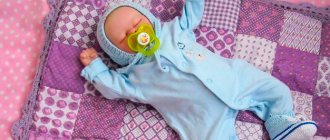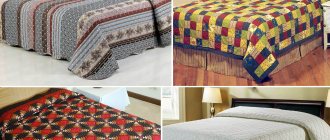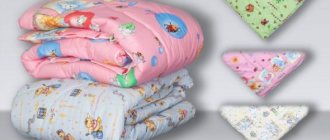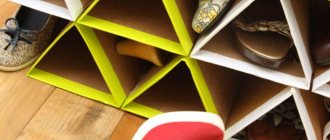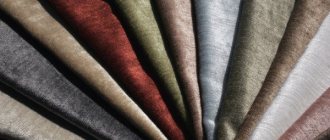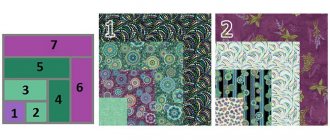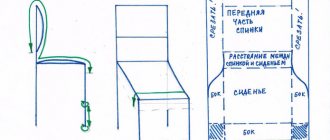With the arrival of a child in the family, caring mothers and fathers try to get the best for him. Young mothers prefer to make certain things themselves. It is not difficult for novice needlewomen to sew a baby blanket with their own hands, showing a little creativity.
Personalized baby blanket for a girl with your own hands - beautiful, stylish and comfortable
Cutting out a blanket
Take measurements before cutting. Dimensions are taken depending on the size of the crib and the purpose of the blanket. To make it gracefully hang from the crib, add an allowance of 15-25 cm to the width and length. There are standard sizes of blankets:
- 90x120 cm;
- 110x140 cm;
- 143x215cm.
There are non-standard sizes:
- 90x90 cm, blanket for stroller, cradle;
- 120x120 cm, blanket for discharge from the maternity hospital, for walks;
- 150x130 cm, blanket - sleeping bag in the shape of a bag, then useful as a simple blanket.
Make a quilt pattern by drawing a rectangle from your measurements, with a 1.5cm seam allowance on all four sides.
Blanket size
Before you start, you need to decide on the size of the blanket for your child.
Your decision will be influenced by:
- baby's age;
- baby crib parameters;
- crib linen that is already in use.
For a child 3-6 years old: the cot mattress will be 120x60 cm in size, and the duvet cover will be 120x90 cm. It is better to choose a size for the blanket that is closer to the duvet cover. If the crib mattress is 160x70 cm, then the blanket is sewn 140x110 cm.
For a child 5-6 years old: crib mattress - 200x90 cm. A blanket with a size of 215x143 cm will be comfortable for a child.
Necessary materials
Choose fabric according to the following criteria:
- wear-resistant and durable, able to withstand repeated washing;
- natural and with antistatic effect (chintz, calico, linen, silk);
- not cause allergies in the baby;
- without toxic dyes;
- all layers must allow air to pass through well.
For the bottom of the blanket, choose a cotton fabric. It is absolutely natural, breathable, but not wear-resistant. Silk and twill are soft to the touch, but require very delicate care. The most acceptable options are cambric, satin, fleece, flannel, calico, bamboo fabric, which meets all the specified criteria. The top part of the blanket can be sewn from any fabric, as long as it is soft and natural.
The following fillers are used.
- Downy – lightweight; soft; air circulates through it, but clumps; it has a characteristic smell.
- Sherstepon – soft; absorbs moisture well and remains dry; It is not recommended to machine wash.
- Sintepon - light; does not provoke allergic reactions; washes well; not expensive.
- Hollow fiber – resistant to knocking down; very warm; does not deform during washing; more expensive than padding polyester.
- Bamboo fiber – meets all criteria; crumples.
The most popular types of filler are padding polyester and holofiber.
Calculate the amount of fabric as follows: take two lengths as measured, take into account a seam allowance of 1.5 cm on each side and 10 cm for shrinkage, i.e. total allowance is 13 cm. Calculate the amount of filler depending on the size of the blanket and the number of layers.
For sewing you will also need threads No. 40-60, machine needle No. 90-100, pins.
Fastenings and transformation mechanisms
When thinking about how to make an envelope for a newborn from a blanket, they immediately consider several options for securing the edges. Acceptable fasteners:
- Zipper is the most practical and convenient item. You just need to choose products that are difficult to get hurt on.
- The ribbons are beautiful, but not practical, bows take a long time to tie and need to be ironed.
- Buttons – you need to choose reliable ones so that they snap easily and hold well.
- Buttons, for them it is better to provide air ribbon rather than slotted loops.
The choice of fixation depends on the age and activity of the baby.
An original envelope blanket, how to fold it and secure it with buttons.
We sew a blanket for discharge
An original, beautiful, convenient and safe envelope for a newborn's discharge
The topic of how to sew a baby blanket for discharge from the maternity hospital is relevant in cool weather. Festive satin and lace envelopes will not work. For this purpose, a transformable blanket is sewn using the same method as a regular quilt on padding polyester. Sew two main parts of the blanket measuring 46x85 cm and 46x60 cm, two side flaps measuring 20x70 cm. Fasten the two main parts and two side flaps to the bottom of the blanket with Velcro, or sew satin ribbons. The top of the blanket can be decorated with lace or pleated ribbon. This blanket can easily be converted into a regular stroller blanket.
Sewing technique
Let's look at how to sew a baby blanket from padding polyester with your own hands, step by step.
Place the fabric on a flat surface, smooth it out, pin the pattern to it with pins and cut out according to the pattern
Cotton fabric detail with stars
Minky soft plush detail
We sew a patchwork quilt with our own hands
Technique for creating a “Watercolor” blanket - combining square patches in the same color scheme, creating smooth transitions
The “Honeycomb” technique is suitable for a blanket made of hexagonal patches in any color scheme
Patchwork is very popular. This is not only an opportunity to use unnecessary scraps of fabric, but a fashionable interior accessory. Unique creations are created from scraps of fabric with figures of animals, cartoon characters, ships, flowers, fruits, etc. It's good to use old, bright children's clothes.
Patchwork technique “Checkerboard” - a blanket made of squares in two colors
The “Stripes” technique is suitable for narrow pieces - instead of squares, strips are used, sewn in a chaotic order
Fabric selection
Before you start, prepare the material from which you will sew a blanket for your baby. First of all, you need to decide whether you will tuck the product into the duvet cover. This will determine the color choice of your fabric and the design of the finished blanket.
You should also remember that during use small accidents will happen - compotes, juices or teas spilled on the blanket, fruits and candies that fall on it should also be remembered. Because of these small annoyances, the blanket will need to be washed occasionally. In addition, children often build houses and huts from blankets and pillows - this will test the strength of the product.
So, the fabric for the blanket should be:
- Durable
- Hypoallergenic
- Well breathable
- Dense
- Eco-friendly
Patchwork Blanket Starter Kit
To sew a patchwork blanket you will need the following kit.
- Pieces of multi-colored fabric with different patterns.
- Fabric for the bottom of the blanket.
- Filler, for example synthetic winterizer.
- Sewing threads of different colors to match the shreds.
- Sewing machine.
- Iron.
- Ruler.
- Scissors or rotary cutter.
- Pins.
A patchwork blanket can be sewn from scraps of various shapes: square, diamond, triangle, stripes. Squares can be of different sizes. The pinnacle of craftsmanship is considered to be the creation of patchwork from a chaotic mixture of scraps. Sometimes this takes many months.
Photo selection of beautiful transforming envelopes for kids:
PreviousTextilesChoosing a quality bedspread for a sofa: tips and recommendations
Next
TextilesChoosing a blanket for a newborn
Sew a bonbon blanket
The “Bonbon” blanket is originally a decorative element of the style, the origin of which is based on the patchwork technique.
The bonbon blanket is a version of patchwork. Sewing it seems incredibly difficult at first glance. It is warm, unusually beautiful, bright. For it, one-color and multi-colored scraps are taken, forming a mosaic. The base fabric is drawn into squares with a side of 11 cm. Cut square pieces with a side of 17 cm are sewn into horizontal stripes, like in a patchwork blanket. The strip is sewn to the base as follows: using pins, the squares of the scraps are secured to the vertical lines of the base fabric, and a fold of excess fabric is placed in the middle of the square for lifting. The resulting voids are filled with holofiber, the squares are attached on three sides to the main fabric using a machine. The following rows are sewn to the bottom edge, continuing until the entire length is filled. The edges of the product are finished with bias tape.
Blankets of this type are sewn from separate ottoman pockets filled with holofiber
Knitting pattern for a baby blanket
- Cast on 139 loops, tie 5 cm high with a double elastic band. In the first row, alternate 1 knit stitch, 1 purl stitch. In the second row, knit the front loop, remove the purl one, leaving the thread in front of you. In the third row, knit the stitch that was slipped in the previous row, and slip the next one, leaving the thread in front of you. Repeat the pattern from the second row.
- Then knit the first and last loops with a double elastic band, 123 loops in the middle - with fancy knitting according to the pattern. For craftswomen who know how to knit, it will not be difficult to find any knitting pattern they like. Knit like this to a height of 83 cm.
- After this, knit 5 cm with double knitting, finish knitting by casting off the loops of the last row.
Makes a cute blanket for a newborn.
Knitted blue blanket complete with baby hat
This is how you can make a baby blanket or baby blanket with your own hands without spending a lot of money. It will warm you up, come in handy for walks in winter, decorate the interior, and serve as a play mat for your child.
Is there any point in doing it yourself?
When deciding to take on sewing a blanket for a child yourself, evaluate all the positive and negative aspects of this work, and only after that make final conclusions. Remember that they will be subjective in their own significance, and if you decide to do everything yourself, you will not regret it in the future. After all, the attitude in the soul towards any thing made with one’s own hands is completely different.
The love invested in the work process has a positive effect on the relationship with the child.
The advantages of a sewn blanket include:
- saving money;
- love invested in the work process has a positive effect on the relationship with the child;
- You will choose the materials used personally, and this will give you confidence that the blanket will be absolutely safe for the baby’s health, and its shade, model and other characteristics will fully meet your wishes.
Among the disadvantages is the need to spend free time on choosing materials and sewing, while there is no complete confidence that everything will turn out perfectly.
In addition, the blanket must meet certain requirements:
- correspond to the season and temperature in the room so that the child does not overheat or freeze;
- the size must be suitable so that the baby feels comfortable;
- there is no excessive decor on the blanket, and its weight should not make it difficult for the baby to breathe.
